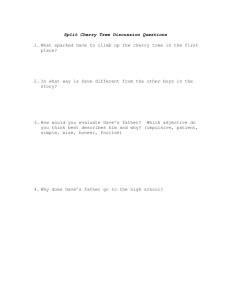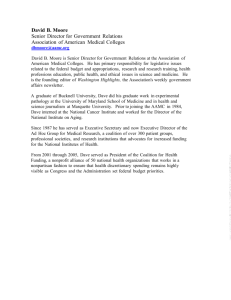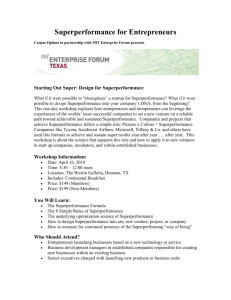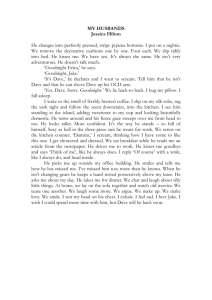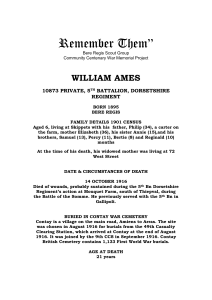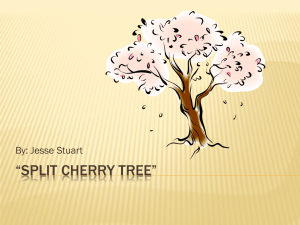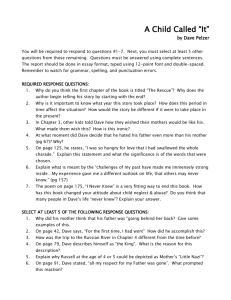MAP READING & NAVIGATION
advertisement
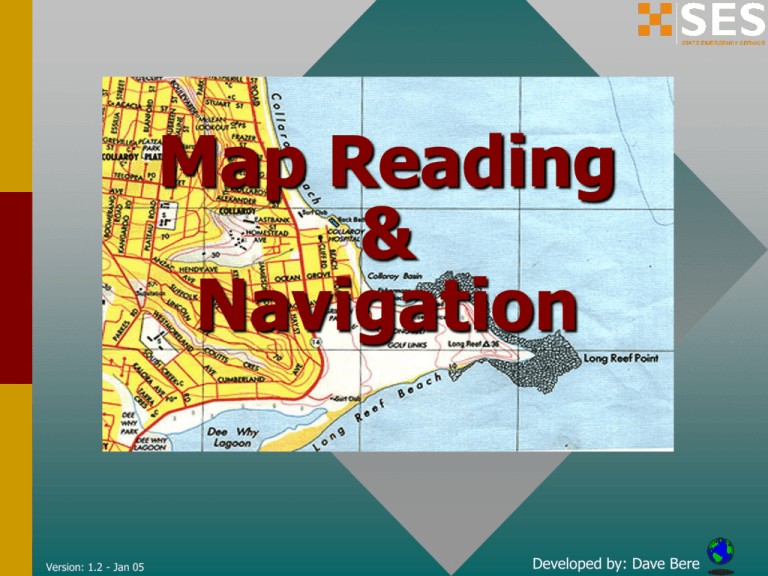
Map Reading & Navigation Version: 1.2 - Jan 05 Developed by: Dave Bere Presentation Overview • Types of maps used within SES • How to use various maps – Scale, Grid references, Ground shape, Gradient etc • Compasses & Bearings • Cross country navigation • Remote area preparedness Version: 1.2 - Jan 05 – (supplement) Developed by: Dave Bere Aim of Map Reading... • To navigate & recognise features on the ground & map. • To picture the ground even though it hasn’t been seen, and. • To understand and pass information quickly. • Determine and plan a safe route. Version: 1.2 - Jan 05 Developed by: Dave Bere Definition of a Map… • Its a scaled representation of the earths surface shown on a plane surface. • It shows natural and/or artificial features. • Used as a form of communication, used to convey land features. • However, its only accurate at time of aerial photo or field revision. Version: 1.2 - Jan 05 Developed by: Dave Bere Types of Maps... • Street directory • Topographic map • Thematic • Scientific • Mud Map Version: 1.2 - Jan 05 Developed by: Dave Bere Street Directory • Edition • Facility index • Key map • Street index • Suburb index • Map & reference Version: 1.2 - Jan 05 Developed by: Dave Bere Topographic Maps Version: 1.2 - Jan 05 Developed by: Dave Bere Map Care & Folding… • Deterioration - dirt, grime, pens/markers & unnecessary opening & folding. • Protecting the map - map case, clear contact, plastic bag or map boards. • Map folding 1. Fold in half (detail facing outward) 2. Concertina into equal sections 3. Fold in half (title showing) Version: 1.2 - Jan 05 TIP Don’t fully open maps in the wind or in the vehicle. Developed by: Dave Bere Marginal Information... • Printed around the margin of the map to aid in using the map. • E.g.. Title, scale, type, legend of symbols, edition & sheet number, adjoining maps, contour interval, magnetic variation, grid reference block, Version: 1.2 - Jan 05 Developed by: Dave Bere Conventional Symbols… • Water features • Structures • Boundaries • Road & Rail • Land features Version: 1.2 - Jan 05 Developed by: Dave Bere Mapping Datum • All mapping & coordinate systems are based on a datum • It’s a mathematical surface (overlay) that best fits the shape of the earth. • AGD66 = Aust Geodetic Datum 1966 – Aust region only • AGD84 = Updated version of AGD66 - USED ON 2ND EDITION TOPO MAPS • GDA94 = Geocentric Datum of Australia TIP - Adopted cause it best fits the earths surface as a whole - USED ON 3RD EDITION TOPO MAPS • WGS84 = Used for Satellite based navigation See map for datum conversions • WGS84 & GDA94 for practical purposes are the same Version: 1.2 - Jan 05 Developed by: Dave Bere Scale… Scale is expressed in 3 methods. 1. In words (One cm = One km) 2. Representative fraction. (RF) 1:25000 E.g 1cm = 25000cm or 250m. TRICK - REMOVE LAST 2 ZEROS TO GET ACTUAL SIZE ON GROUND IN METRES 1:10,000 to 1:100,000 are small scale 1:250,000 to 1:10 million are large scales 3. Linear scale - scaled ruler. Version: 1.2 - Jan 05 TIP As the second number increases, detail shown on the map decreases Developed by: Dave Bere Measuring Distance… • Measuring straight line distance (map) – Paper – Divider – Ruler • Measuring distance along a road/track (map) – Curved paper – Length of string Version: 1.2 - Jan 05 Developed by: Dave Bere Map Coordinates • 2 Types – Geographical coordinates given as latitude and longitude – Grid coordinates given as Eastings & Northings Latitude & Longitude • Uses degrees, minutes, minutes – Each degrees & minutes is divided into 60 graduations • Horizontal lines (Parallels of latitude) – (N or S of equator) • Vertical lines (Meridians of longitude) – (E or W of Greenwich) 0 0 • S31 51’ 0” E115 54’ 3” Note: All Australian Lat & Long coord’s are south & east Version: 1.2 - Jan 05 Developed by: Dave Bere Grid Coordinates • Used to accurately locate/position objects on a map. • Two sets of numbered parallel lines (vertical & horizontal) intersecting at right angles to form squares on a map. • Superimposed over the map to provide a reference system. • Grid squares are generally 1km 2. • Grid lines are defined as ‘Eastings’ & ‘Northings.’ Version: 1.2 - Jan 05 Developed by: Dave Bere Cont’… • Eastings are the vertical lines, numbered left to right. • Northings are the horizontal lines numbered bottom to top. • Read ‘Eastings’ first, then ‘Northings’. Version: 1.2 - Jan 05 TIP Across first, then up Or E before N 99 00 01 02 03 03 02 01 00 99 Developed by: Dave Bere 4 Figure Area References… • The co-ordinates represent the whole square, not just the single point. E.G 1201 2 represents 1km • Find ‘12 easting’ first. 11 12 13 03 02 01 00 • Find ‘01 northing’ second. Version: 1.2 - Jan 05 Developed by: Dave Bere 6 & 8 Figure Grid References… • A 6 figure reference is 1/100th the size of a 4 figure reference. 12 02 E.G 122016 - represents 100m 2 • 8 Figure Grid References 01 13 123456789 9 8 7 6 5 4 3 2 1 • Romers Version: 1.2 - Jan 05 Developed by: Dave Bere GPS… • Global Positioning System (satellite based navigation) – Features included: • Your position on the Earth’s surface • Your current height - ASL • Your speed and direction of travel • Lat/Long or UTM • Different world datums – WGS84 • Signal doesn’t penetrate buildings or thick scrub. • Uses triangulation principle to pinpoint location. • Minimum of 4 satellites are needed for an accurate 3D position • Typical accuracy is within 30m - 95% of the time • Developed by US Defence system • Interfaces with your PC and mapping software • Uses 24 satellites orbiting the Earth twice a day • Consult users guide for operating instructions Version: 1.2 - Jan 05 Developed by: Dave Bere Universal Grid References… • Also known as UTM – Universal transverse Mercator • A grid system is superimposed over the world map. • Each square is uniquely identified. E.G 56h • Every square is further bisected by another 100 squares. E.G 56hlh • So forth until the squares are bisected into 100sq metres. • E.G 56hlh10 56hlh1201 56hlh122016 Version: 1.2 - Jan 05 Developed by: Dave Bere Ground Shape… • Allows the user to visualise the surroundings • Ground shape is referred to as relief. • Relief can be shown as: – Hachures – Hill shading & – Contours Version: 1.2 - Jan 05 Developed by: Dave Bere Contours… • A contour is a line that joins points of equal elevation • Contour interval is the vertical distance between contour lines • See legend for contour interval Version: 1.2 - Jan 05 Developed by: Dave Bere Contour Patterns… • Contour lines close together show steep slopes • Contour lines far apart show gentle slopes • Contour lines evenly spaced show uniform slope • If the spacing decreases when going from high to low, the slope is convex • If the spacing increases when going from high to low, the slope is concave Version: 1.2 - Jan 05 Developed by: Dave Bere Land Features… • Representation of height – Bench mark, trig station, spot height • Physical features – Knoll – Saddle – Spur, ridge – Valley, gorge – Escarpment – Re-entrant – Crest – Plateau Version: 1.2 - Jan 05 Developed by: Dave Bere Gradient… • A method of expressing ground slope. • Gradient = Contour interval (height) Horizontal Distance 1:10 = 1 unit up or down / 10 units across. 0 1:1 is a 45 Simplify to smallest fraction = 20 = 1 = 1:6 120 Version: 1.2 - Jan 05 6 Developed by: Dave Bere Intervisibility – Line of sight • Used to determine the location of radio repeaters (particularly VHF) & fire lookout towers Version: 1.2 - Jan 05 Developed by: Dave Bere Map Enlarging • Map enlarging produces a portion of map at a larger scale. (see learners guide) Version: 1.2 - Jan 05 Developed by: Dave Bere Compass… • Degree system - (3600 circle) – North = 0/3600 – South = 1800 – East = 900 – West = 2700 • Cardinal points – 32 in total, – only 16 are used. Version: 1.2 - Jan 05 Developed by: Dave Bere Bearings… • The purpose of a bearing is to give an accurate indication of direction from one point to another. • Simply, a bearing is an angle. • It is the angle measured clockwise from a fixed zero line, generally north. Version: 1.2 - Jan 05 • Grid bearings – Used when bearings are taken from or to the map. • Magnetic bearings – Used in conjunction with a compass. This type of bearing is for field operation. • Bearings are measured using a protractor or compass. Developed by: Dave Bere Bearings - Cont’ N N A X A 31 37 0a = 37 0 0b = 75 AB = 31 if ‘A’ is specified 0c = 304 0 N C 75 b B N 304 0 0 Version: 1.2 - Jan 05 Developed by: Dave Bere North Points… • True north - TN – Earth spins on this axis • Magnetic north - MN – Compass needle points to magnetic north – Its a location in the far north of Canada • Grid north – GN – The vertical lines overlayed on a map point to grid north – (eastings) – Not exactly true north. – Difference between TN & GN is called convergence • In map reading we only use GN & MN Version: 1.2 - Jan 05 Developed by: Dave Bere Magnetic Variation… • The difference between ‘grid north’ & ‘magnetic north’ is called magnetic variation. • The magnetic north pole is not fixed, it moves continually • Easterly & westerly variation • Check map for accuracy of variation Version: 1.2 - Jan 05 Developed by: Dave Bere Converting Bearings • Mag’ bearings must be converted to Grid bearings for plotting. • Grid Bearings taken from map must be converted to Mag’ for compass work • To convert bearings – simply add or subtract variation • GMS = Grid to Magnetic – Subtract (GrandMa Sux) • MGA = Magnetic to Grid – Add (My Green Apple) • Grid bearings are always larger than a magnetic bearing with an easterly variation Version: 1.2 - Jan 05 Developed by: Dave Bere Back Bearings… • A back bearing is the bearing immediately opposite the current bearing 0 • Add 180 if bearing is 0 smaller than 180 0 • Subtract 180 if bearing is larger than 0 180 • Reversing compass Version: 1.2 - Jan 05 Developed by: Dave Bere Compasses… • Many types & shapes. – Prismatic, reflective & Silva • Consist of – Magnetised needle – A non ferrous or plastic box 0 – A graduated 360 circle and – Sometimes an aiming point Version: 1.2 - Jan 05 Developed by: Dave Bere Parts of a Compass… • Silva Compass Version: 1.2 - Jan 05 • Prismatic Compass Developed by: Dave Bere Taking a Grid Bearing… • Using a compass & map. – Place edge of compass along intended bearing. – Direction arrow points the way you want to travel – Turn housing so meridian lines are parallel to easting lines – Read grid bearing where housing and index intersect Note: This bearing must be converted to mag’ bearing if intended for field use. Version: 1.2 - Jan 05 TIP Ignore the needle when using compass as a protractor Developed by: Dave Bere Magnetic Bearings • Setting a Magnetic bearing – Hold compass flat in palm – Set bearing on compass by rotating housing – Turn yourself till red needle lines up with north – Now walk in direction of directional arrow Version: 1.2 - Jan 05 • Taking a Magnetic bearing – Hold compass with directional arrow pointing at intended object/direction – Rotate housing till north aligns with red arrow – Read bearing where index lines intersects Developed by: Dave Bere Magnetic Bearings cont… • Compass back bearings – Face the opposite direction, turn compass around & walk with directional arrow pointing towards you. – Or use white needle as directional indicator • Compass Error – Individual compasses – Local magnetic attraction due to steel/iron ore • Transmission lines = 80m • Car = 60m • Wire fence = 10m • Pick, Axe or shovel = 3m Version: 1.2 - Jan 05 TIP The desk you’re sitting at has local magnetic attraction Developed by: Dave Bere Cross-country Navigation • Factors influencing C-C navigation – Weather, terrain, vegetation, visibility – Team composition, fatigue – Access restrictions, boundaries, route choice • Improvised direction finding – By shadow stick & sun – By the stars – By using a watch & sun – Bushman's method – kangaroos – GPS Version: 1.2 - Jan 05 Developed by: Dave Bere Cross Country Navigation cont… • Predicted walking time – 5km/hr easy going – 3km/hr easy scrambling – 1.5km/hr rough country, snow, sand or thick bush – Add 1hr for every 500m up or 1000m down – Every 5 hrs allow an 1hr for fatigue. • Distance travelled pacing & time – Average step is 75cm – Approx’ 650-660 right steps = 1km • Judging distance - See Learners Guide for object sizing P79 – Unit of measure (Good up to 400m – Sports fields or swimming pools) – Appearance (Takes a lot of practice – compare with surroundings) – Bracketing (Greater than 200m, Less than 600m) Version: 1.2 - Jan 05 Developed by: Dave Bere Planning….. • Route planning – Map study – Essential, you must have a good plan before setting off. – Have an alternate plan & route – Break route down into individual legs. – Each leg should terminate at recognisable objects or within an hour • Consider • • • • • Version: 1.2 - Jan 05 Grain of country Ridges Rivers Dense scrub Access Developed by: Dave Bere Map Orientation… • A simple way to read a map is to orientate the map to its surroundings. • Using land features – Lay the map on the ground. Rotate map till features on ground align with those on map. • Using a compass (mag) • Using a compass (grid) – Determine & set mag’ variation on compass – Align compass edge with ‘N-S’ meridian lines – Rotate map & compass till compass needle is aligned Version: 1.2 - Jan 05 – Draw mag’ variation lines on map – Set compass to mag’ ‘N’ – Align compass edge with drawn lines – Rotate map & compass till compass needle is aligned – All compass bearings can now be taken directly from the map Developed by: Dave Bere Lateral Drift • Is when you drift away from the given destination, but you remain on the same bearing. • The compass alone, is not enough to eliminate lateral drift. • Spot a feature (tree, knoll) on the set bearing, walk to that feature, then reassess. Continue until destination is reached. Version: 1.2 - Jan 05 Developed by: Dave Bere Avoiding an Obstacle • Used to traverse around cliffs, knolls, swamps etc 0 • Pacing at 90 intervals • Leg 1 and 3 need to be of equal distance Version: 1.2 - Jan 05 Developed by: Dave Bere Checking… • Attack points – Used when navigating to less identifiable features – Easier to find an attack point than a specific reference – A well defined location – Gets you close to your given destination – E.G. Road junctions, man made structures, prominent knolls etc. • Aspect of slope & Hand rails Version: 1.2 - Jan 05 • Catching features – Easily identified features. Eg fences, creeks roads – Should prevent you from walking too far • Aiming off – Aiming left or right of given bearing or location – Used so you don’t overshoot the mark – E.G. Creek junction - aim for creek, then walk up or downstream till you hit the creek junction Developed by: Dave Bere Position Fixing – Resection… • Used when you’re unable to fix your position from the ground to that on the map. • Find 2 or 3 prominent features. • Take magnetic bearing of features & convert to grid bearing. • Change to back bearing & plot all bearings on map. • Your position is where the back bearings intersect. Version: 1.2 - Jan 05 Developed by: Dave Bere Action If Lost!!! • Don’t PANIC, remain calm • Re-think route & confirm ground covered • Position fixing -resection • Identify a bearing (track junction) & head for safety • Unable to identify your position, set up camp & wait for rescue • Initiate any distress beacons TIP You’re never lost, just geographically misplaced Version: 1.2 - Jan 05 Developed by: Dave Bere Remote Area Section… This section is not pitched at any level of expertise. Everyone should be well prepared before entering the bush. • 6 P’s = prior preparation and planning prevents poor performance. • Learn the area before departing • Have a navigational route planned – Group details – Route details – Intended camp locations – ETD and ETA Version: 1.2 - Jan 05 Developed by: Dave Bere Basic Requirements for Survival… • Water • Warmth – Minimum 2ltr/day – Dry clothes – Is there water in the area – Thermals – Carrying capacity – Matches/lighter – Quality – Strategies/procedures to cope with the cold • Shelter – Tent or hutchie – Ground sheet – Improvisation – E.G. Caves, overhangs, huts, sheds Version: 1.2 - Jan 05 • Food – Enough food/nourishing – Hunting & gathering food – Rationing – Cooking/disease Developed by: Dave Bere Navigational Tips - (Generalised) • Sparse & scratchy vegetation along ridges & spurs • Thicker vegetation through gullies & valleys • South facing terrain is thicker vegetation • Slower moving through creek beds • Night navigation - use of lighting and the moon • Pack light, pack right • You’re only as fast as your slowest team member • Continue relating features from the ground to the map • Carry safety equipment & have knowledge of remote first aid • Know your limitations - be mentally & physically prepared Version: 1.2 - Jan 05 Developed by: Dave Bere Pack Checklist… • Clothing • Personal equipment – Boots & socks – Backpack – Underwear & thermal – Sleeping bag – Trousers/shorts – Sleeping mat – Shirts – Toiletries – Jumper/jacket – Toilet paper – Headgear & gloves – Water bottle & water – Wet weather jacket & pants – Food & utensils – Gaiters – Light source batteries Version: 1.2 - Jan 05 – Insect repellent/sunscreen Developed by: Dave Bere Pack Checklist… • Emergency equipment • Group equipment – Maps & map case – Tent or hutchie – Watch – Ground sheet – Compass – Stove & fuel – Whistle – Water filter – Fire starters – Plastic shovel – Knife – Cordage – Note book & pen – GPS Version: 1.2 - Jan 05 The End Developed by: Dave Bere
